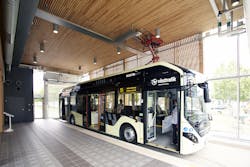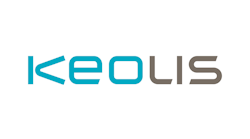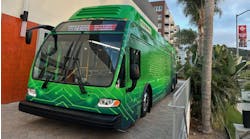ElectriCity: The Bus Service of Tomorrow
Gothenburg, Sweden adopted a long-term strategy to achieve sustainable growth based on comprehensive research: Gothenburg 2020. Key objectives include extension of the infrastructure in the region and doubling the market share of public transportation in 2025.
Helping to achieve sustainable transportation, ElectriCity is a cooperative venture testing new solutions for sustainable public transportation. It is a partnership between 14 different partners, including Västtrafik, the local public transportation provider; Keolis, an operator for Västtrafik; and The Volvo Group, the manufacturer of the vehicles, and brings together industry, research and society in the development and testing of new solutions for next-generation sustainable public transportation.
Västraffik is the agency responsible for public transportation, including buses, trains, trams and ferries, in the county of Västra Götaland, Swedend. There are 900 routes spread out across Västra Götaland.
Västraffik has about 80 partner companies who operate its routes and sell its tickets. There are about 9,000 employees that run the service, 300 of those are Västraffik employees.
Lars Backström, Västraffik CEO, stressed their vision is for customers to choose the service because they want to, not because they have to. Because of this, there are different forms of contracts, but most are passenger-incentive contracts with bonuses on customer satisfaction. “We want our partners to make money; we don’t want them to bid too low.”
One of the main objectives of Västraffik is to have twice the ridership by 2025 while seeing an increase in customer satisfaction. Contributing to a sustainable environment, they intend to have a 95 percent reduction of fossil fuels by 2025, 25 percent less energy consumption overall and a 60 percent reduction in emissions.
Line 55
A central part of ElectriCity is Västraffik’s Line 55, a demonstration project that started June 15, 2015. A variety of research is being done with the project that offers a quiet, exhaust-free ride that picks passengers up indoors and powered by electricity from renewable sources. They are looking to answer questions such as what a silent bus means for safety, how to improve traffic management systems, how the electric supply system be built and what the best safety concepts are for public transportation.
Volvo ElectriCity Service Market Nordic Christser Olsson explained the route connects two universities and goes from Chalmers/Johanneberg Science Park to Lindholmen Science Park, a 4.7-mile route with 10-minute
Ten buses run on the route, three of which are all-electric and the remaining seven are electric-hybrid. The electricity for the buses is exclusively renewable, coming from wind power and hydro power.
The all-electric bus is a concept vehicle, the first fully electric bus from Volvo. It is quiet, emission-free and 80 percent more energy-efficient than a conventional diesel-powered bus. The all-electric buses are 35 feet and can carry 80 passengers. The electric-hybrids are 39 feet and have the same capacity. As you don’t have the heat from the engine like a conventionally fueled bus, there are supplemental heaters inside the bus for passenger comfort.
To increase the overall efficiency, the doors are much wider to allow quick boarding. The vehicles and the stops have Wi-Fi so customers don’t have a disruption in connection and the bus even has outlets for charging devices. The regular fixed-route service vehicles are blue, while Line 55 buses are green so they really stand out in the community.
The electric motor is powered by lithium-ion batteries and utilizes regenerative braking to charge the batteries. Recharging also takes place at the two end stops. Recharging takes about 6 minutes. The vehicles run 6.2 miles between charges, but could run up to 18.6 miles. Training the driver to stop in the right position took about 2 days; there’s about an 8 to 11-inch leeway for charging. Energy loss during the charge is very low due to the direct contact.
Volvo press officer Jessica Sandstorm said they went with in-route charging because they determined it could be problematic to charge a lot of buses on the grid at one time overnight, plus it puts restrictions on operating hours. She also said that studies by Chalmers University showed it’s more cost-effective for the on-route charging because there's not a massive amount of charging infrastructure sitting unused for long periods of time.
The energy consumption is very low from the buses. Even if all of the vehicles were all-electric, it would be about 1 percent of energy use.
Olsson said the charging infrastructure, which has the pantograph, is maintained by the electric company.
Managing Director of Volvo Group Ulf Magnusson said the future of public transportation will be a mix of hybrid, electric-hybrid and all-electric buses. One of the challenges of converting to all-electric is working with all of the stakeholders. In Gothenburg, he explained, there were 14 stakeholders. He stressed, “Engage multiple stakeholders at the beginning, otherwise this will fail.”
Keolis was contacted by Volvo about this project 1-1/2 years ago and Magnus Åkerhielm, CEO Keolis Sverige, said they strongly believe that electric buses are part of the future.
Comfort Stop
The outdoor stops along the route feature interactive screens, infotainment, Wi-Fi that is also on the bus and AC outlets. At one end of the line, at Teknikigatan Lindholmen, riders can utilize Gothenburg’s first indoor bus stop.
The indoor stop provides protection from the weather, is quiet and clean, creates a social meeting place and offers new possibilities.
One of the areas of research for Chalmers is looking at how control technology can be used to control the climate and minimize energy loss. The bus sends data to the indoor stop so the building is prepared, including how many people are on the bus.
Chalmers will also look at the increased costs with the indoor stop in relation to the potential value added for the passenger experience.
The Future
Jean-Pierre Farandou, president of Keolis, said Sweden is a front runner in both alternative energy and in growing public transportation. Working toward reducing its own footprint, Keolis is ISO-140001 certified and has goals to optimize its use of energy, water conservation and reducing its fossil fuel use.
As a provider of public transportation service, Farandou said it’s Keolis’ job to help cities become more sustainable and to make public transportation an ideal choice for citizens. “We need to get people to leave their cars at home.”
Backström said Västraffik conducts 30,000 interviews on board the buses, trains, trams and ferries each year for customer satisfaction. They are seeing that 95 percent of the customers are satisfied with their most recent journey and 79 percent trust Västraffik to get them to their destination on time.
This past summer, 275,000 journeys were taken on route 55 and six out of 10 riders say the environmentally friendly vehicles make this an attractive choice.
The collaboration partners will continue to research what the future of sustainable public transportation should look like as they test this platform. Not only looking at electric bus operation, thie project will help them understand how cities can be planned in new ways.
ElectriCity Collaboration Partners
The Volvo Group is the initiator of ElectriCity and is responsible for development of the electrified vehicles and transportation solutions used in the project.
Västra Götalandsregionen is responsible for public transportation throughout Västra Götaland and it owns Västtrafik.
Västtrafik is the provider of all public transportation within the region of Västra Götaland. The electric buses used on line 55 will be part of the public transportation system.
The city of Gothenburg is growing and developing with the goal of becoming a denser, more sustainable and open city that offers an attractive environment and a rich urban lifestyle.
Chalmers University of Technology's vision is to actively contribute to a sustainable future. Chalmers coordinates the research activities of ElectriCity.
Swedish Energy Agency supports the development of the all-electric buses.
Johanneberg Science Park investigates which areas in the borderland between construction and public transportation, including the issues of urban planning associated with these, that need to be studied, analyzed and development further in order to make an upscaling of ElectriCity possible. It will also examine which steps need to be taken in order to enable an upscaling of silent bus stops.
Linholmen Science Park's emphasis for the project is on generating research and development projects that can be linked to the main project to ensure ElectriCity emerges as a national demonstration platform.
Business Region Göteborg (BRG) works to create sustainable growth in trade and industry in the region.
Göteborg Energi is the energy company for the residents of Gothenburg. They are involved in the project to provide a supply of renewable and sustainable energy power for the electric buses.
Keolis is the company that operates the buses in the ElectriCity project on behalf of Västtrafik.
Älvstranden Utveckling’s role is creating a secure, environmentally optimized and comfortable public transportation for next-generation mobility.
Adademiska Hus is a property company that believes public transportation is with attractive bus stops is an important matter for society as a whole.
Chalmersfastigheter is Chalmers’ property company and ElectriCity enables it to increase the appeal of traveling by public transpottation between the two Chalmers campuses. They built the indoor bus stop, which represents an opportunity for research into the energy-efficient, dense cities of the future.
By the Numbers
Route 55
Opened: June 15 2015
Length of route: 4.7 miles
Number of all-electric vehicles: 3
Number of electric-hybrid vehicles: 7
Time for a charge: 6 minutes
Distance between charges: 6.2 miles
Number of charging stations on the route: 2





